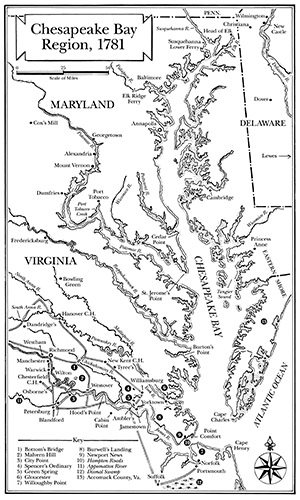Major General Lafayette to George Washington, 24 May 1781
From Major General Lafayette
Richmond May 24th 1781
Dear General
The jonction of Lord Cornwallis With the other Army at petersburg Was An Event that from Local Circumstances and from their So Great Superiority it Was impossible to prevent—it took place on the 20th1 and Having Lost Every Hope to Operate a timely Stroke in Conjonction With the pennsylvanians, My ideas Were Confined to defensive Measures2—I therefore Moved Up to Richmond Where precautions Were taken to Remove Every Valuable property Either public or private.
By An officer that Was in Hallifax After Lord Cornwallis I find He Has Not left Any post at that place—it Appears His Sick And Wounded Remained at Willmington and Were Reimplaced By that Garrison—Reports Concerning His Numbers Are So Different that I Cannot trust Any thing But My Eyes—Untill Such An Oppertunity Offers, this is the Order of March in Which it is said His Lordship Crossed Roanoke—Clel Tarleton’s Legion, Clel Hamilton’s Corps, 23d, 71st, 33d British Regiments; 200 tories, An Hessian Regiment the Light infantry and Guards With Six field pieces—I am told General Leslie and General O Hara Are With Him. I Have Received Successive and Repeated Accounts that a British fleet of transports Was Arrived at Hampton—they were Said to Consist of 14 large Vessels, and 16 Smaller ones under Convoy of three frigats3—Mister day d.q.m. at Williams Burg writes that on the 22d 12 Sails of large Ships a Sloop and A Schooner Got Under Way Opposite james Town—those ships full of men, and some Horses on Board the Sloop4—We Have No Accounts of Any fleet Having Sailed from New york.
Yesterday After Noon We Had an Heavy Rain Which Colonel Tarleton Improved in Surprising Some Militia in Chesterfield County thirty of Whom fell into His Hands.5
This Morning at Nine o clock the Ennemy Moved from petersburg towards City point And Destroied the Bridge they Had Lately Constructd Over Appamatox—I Have just Received Accounts that A Body of them Has Landed at Westover—these are Said to Be the Men Who Came up the River from Hampton, previous to Which General Arnold Had Received a Small Reinforcement from porsmouth.
To My Great Mortification, I Have Heard this Morning that the pennsylvanians Are not So Near as I Had Been By Every Account positively Assured—General Waïne writes me He will Hasten to My Support and I am Confident He will Not loose time at this Critical Moment6—But Before He Arrives it is impossible that 900 Continentals and 40 Horse With a Body of Militia By no Means So Considerable as they are Reported to Be and whom it is So difficult to Arm, Be With Any Advantage opposed to Such a Superiority of forces, Such a Number of Cavalry, to Which May Be Added their Very prejudicial Command of the Waters.
Our Handfull of Men Being the point to which Militia May Be Collected, and the only Check, However Small it is, that the Ennemy May Have in this state, it ought I think to Be Managed With A Great deal of prudence As its preservation is So Very important to the fate of Operations in Virginia. With the Highest Respect I Have the Honor to Be Your Excellency’s Most obedient Humble Servant
Lafayette
ALS, DLC:GW; copy, DNA:PCC, item 156; copy, PEL. GW’s aide-de-camp Tench Tilghman docketed the ALS: “acknowledged by the General himself” (see GW to Lafayette, 4 June).
1. On 20 May, Lt. Gen. Charles Cornwallis wrote Gen. Henry Clinton from Petersburg, Va., that the “corps which I brought from North Carolina arrived here this morning” (, 5:87–88).
2. For efforts to send a division of the Pennsylvania line to Virginia, see Anthony Wayne to GW, 7 May.
3. For the departure of these transports and their escort from New York, see

Map 7. Lafayette waited in vain for reinforcements to help prevent a convergence of British troops at Petersburg, Va. (Illustrated by Rick Britton. Copyright Rick Britton 2022)
William Heath to GW, 1 May, n.1. Hessian captain Johann Ewald wrote in his diary that “on the 23d the troop reinforcements arrived in Chesapeake Bay and sailed to City Point” (, 299).
4. The letter from Benjamin Day to Lafayette has not been identified.
5. Lt. Col. Banastre Tarleton later wrote of this engagement: “A patrole under Lieutenant-colonel Tarleton being pushed to Warwick court house, fell in with a party of four hundred militia in that neighbourhood, who were routed with great loss to the Americans, and a trifling detriment to the British, the former being surprised, and the latter considerably shielded by a heavy fall of rain, which prevented the militia from using their fire arms: Fifty Americans were conducted to Petersburg: From the prisoners and by emissaries it was clearly discovered that about one thousand continental troops were posted between Wiltown and Richmond, waiting the junction of General Wayne with the Pennsylvania line, and the expected reinforcements of militia” (, 292).
6. Brig. Gen. Anthony Wayne wrote Lafayette by express on 19 May to assure him that his division of the Pennsylvania line would march from York, Pa., on 23 May (see , 4:114–15; see also Lafayette’s second letter to GW, this date). The division marched on 26 May (see Wayne to GW, that date). Wayne’s division joined Lafayette’s corps on 10 June (see the entry for that date in , 4; see also Lafayette to Wayne, 7 June, and Wayne to Lafayette, same date, in , 4:171–72).

![University of Virginia Press [link will open in a new window] University of Virginia Press](/lib/media/rotunda-white-on-blue.png)
